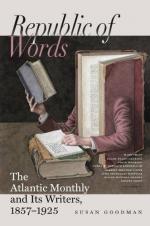It was no great feat, after all, considering that I had been for five years a gymnast. I found that I was inharmoniously developed in many points of my frame,—was perilously weak in the sides, between the shoulders, and at the back of the head. However, the day after this trial, I succeeded in lifting the same weight with somewhat less difficulty. This induced me to add on a few pounds; and in three or four weeks I could lift between six and seven hundred. I now had the satisfaction of seeing the stout gentleman, whom a few months before my father had pointed out as possessed of a strength I could never attain to, introduced to an inspection of my apparatus. Through the blinds of a back-parlor window I watched his movements, as, encouraged by pater-familias, he drew off his coat, moistened his hands, and undertook to “snake up” the big weight. An ignominious failure to start the barrel was the result. The stout gentleman tugged till he was so red in the face that apoplexy seemed imminent, and then he dejectedly gave it up. The reputation he had long enjoyed of being one of the “strongest men about” must henceforth be a thing of the past till it fades into a myth.
In the December of 1855 I was admitted to the arcana of the dissecting-room, and forthwith commenced some experiments with the view of testing the sustaining power of human bones. Some one had told me, that, in lifting a heavy weight, there was danger of fracturing the neck of the thigh-bone; but my experiments satisfied me, that, if properly positioned, it would safely bear a strain of two or three thousand pounds. And so I concluded that I might securely continue my practice of lifting till I reached the last-named limit.
In order to get all possible hints from the inspiration and experience of the past, I studied some of the ancient statues. The specimens of Grecian statuary at the Boston Athenaeum were objects of my frequent contemplation,—especially the Farnesian Hercules. From this I derived a proper conception of the bodily outline compatible with the exercise of the greatest amount of strength. I was particularly struck by the absence of all exaggeration in the muscular developments as represented. I saw by this statue that a Hercules must be free from superfluous flesh, neatly made, and finely organized,—that form and quality were of more account than quantity in his formation. Some years earlier I might have been more attracted by the Apollo Belvedere; but it was a Hercules I dreamed of becoming, and the Apollo was but the incipient and potential Hercules. Two other statues that shared my admiration and study were the Quoit-Thrower and the Dying Gladiator. From the careful inspection of all these relics of ancient Art I obtained some valuable hints as to my own physical deficiencies. I learned that the upper region of my chest needed developing, and that in other points I had not yet reached the artist’s ideal of a strong man.




